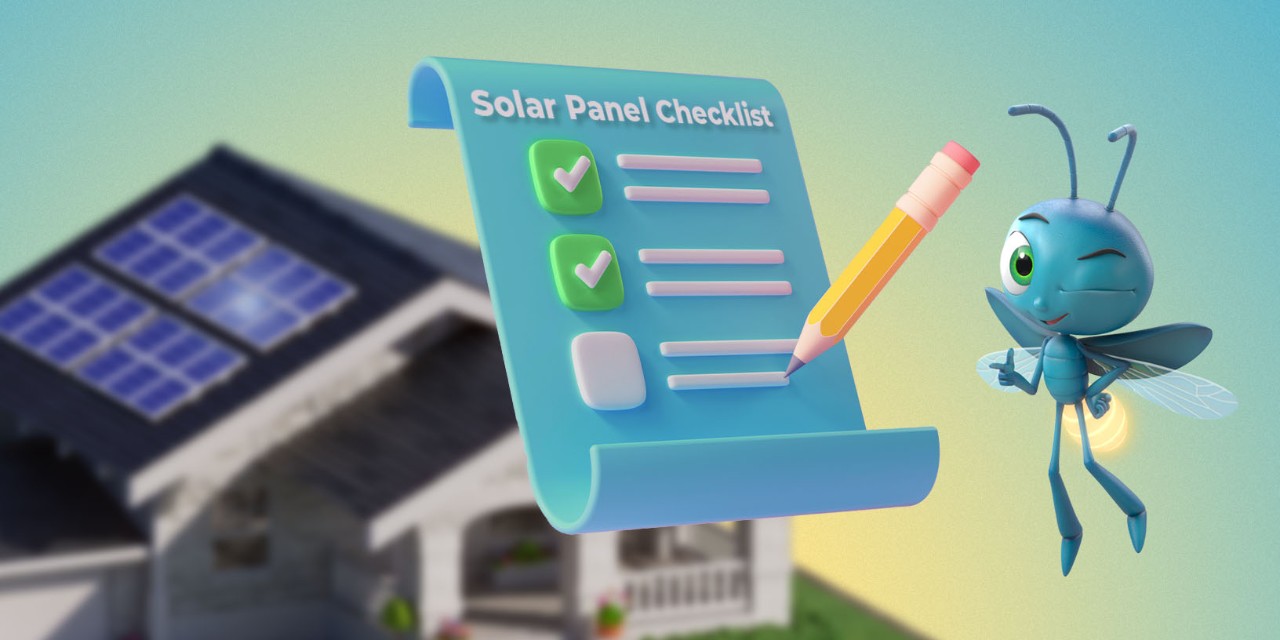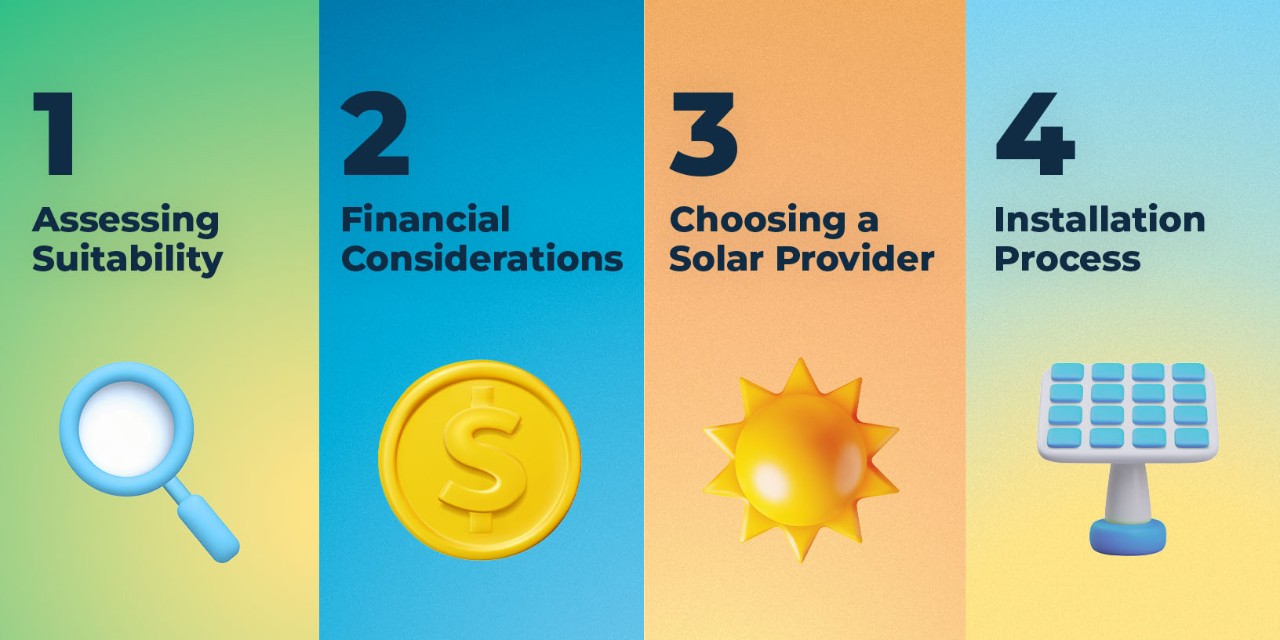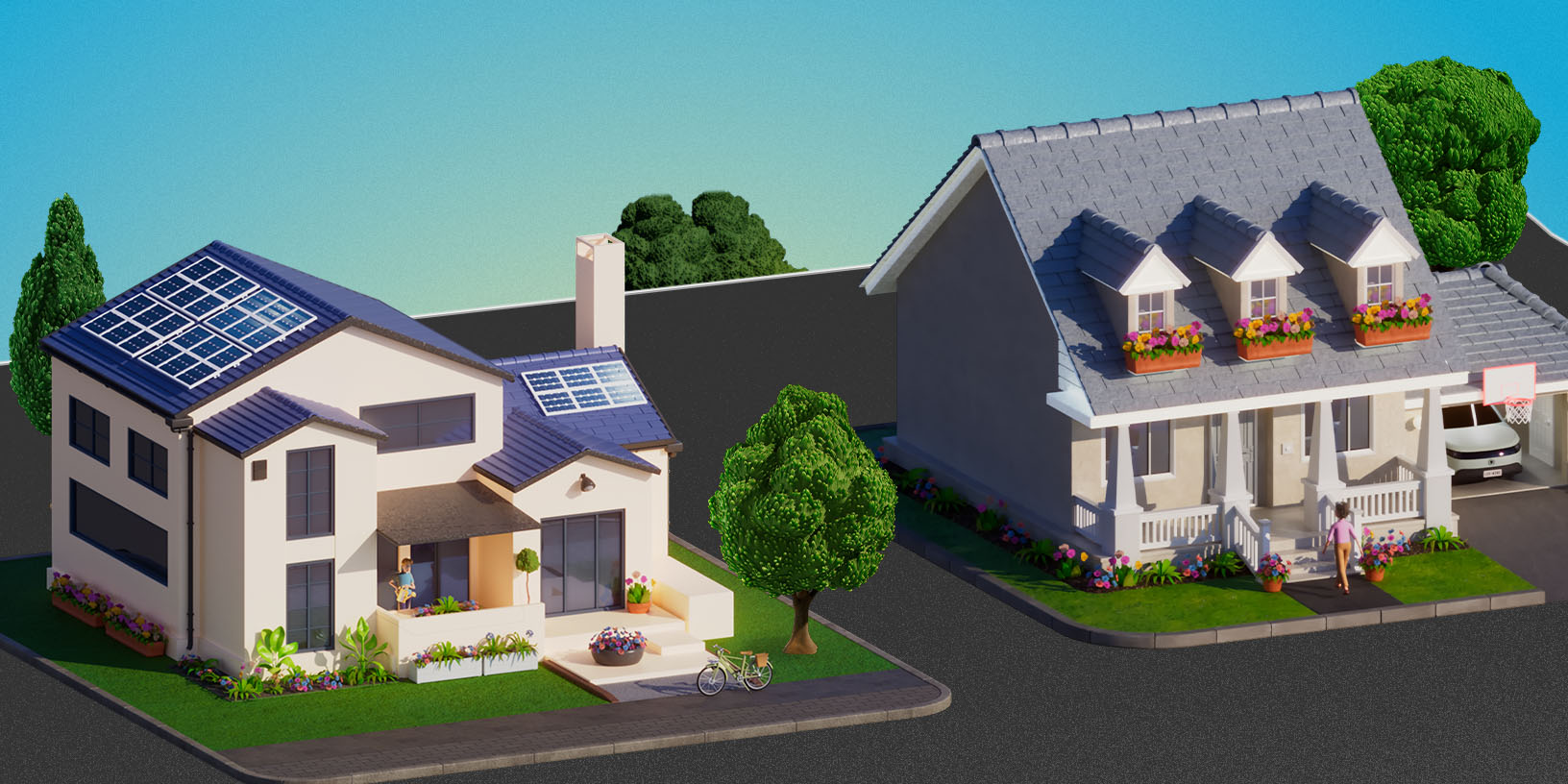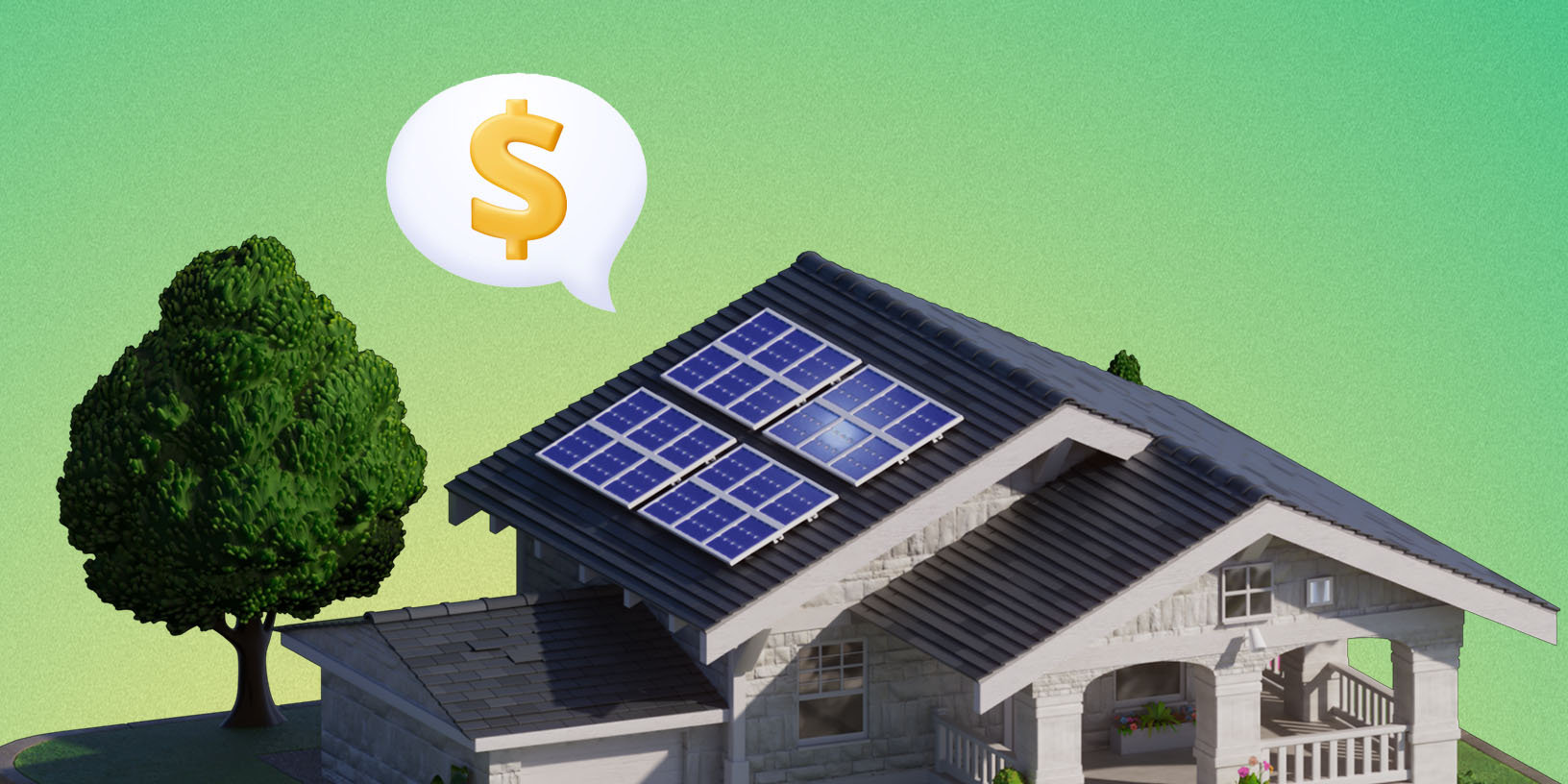Green Mountain Energy's Guide to Going Solar
How to Get Started on a Solar Panel Installation

The layered benefits of solar panel installation are undeniable. Not only can you reduce your carbon footprint and power your home with a renewable energy source, but also, through buyback programs and federal incentives, seeing the return on your solar power system installation is more accessible than ever.
Green Mountain Energy has been proud to support the growth of sustainable energy sources for over 25 years. We’ve made it our mission to inspire hope and motivate action through the use of clean energy.
In this article, our goal is to guide you through the details of the residential solar panel installation process so that you get a full picture of what to expect when starting your solar panel journey.

Assessing Your Suitability for Residential Solar Installation
Your first step is to self-assess whether your home and property are suitable for solar panel installation.
Let’s look at some key factors to consider:
- Roof orientation: South-facing roofs typically receive the most sunlight, which makes them ideal for solar panels.
- Region: How much sunlight do you receive in a day? How’s the weather? Low sunlight hours or frequent cloudy days can play a part in whether solar panel installation is right for you.
- Roof conditions: Consider the overall type, age, size, and condition of your roof. If your roof needs work, this may impact whether it is able to support a roof-mounted solar array.
- Tree cover: The amount of tree cover over your home can have a sizable impact on whether the sun will reach your panels.
- Available space: Adequate roof space is necessary to install a sufficient number of panels. For example, a Craftsman, Hill Country, or contemporary roof style may leave less space for panels than a ranch-style home.
- HOA rules: Before initiating your installation, check with your homeowners association for any regulations regarding solar panel installations.
Consider as well that when looking at home solar panel options, you do not necessarily have to install it on your roof. There are plenty of options for ground-mounted solar panels as well.
Your Local Climate
While it’s a common misconception that hotter climates produce more solar energy, efficiency can decrease at very high temperatures.
Also, many “hot” locales in the United States experience more humidity, which not only makes warm temperatures feel higher but can also increase cloud cover and harsh weather conditions (which directly affect how much solar energy your panels could produce).
On the other hand, cold climates and precipitation like snow and ice can affect the longevity and performance of your solar panels. With snow and ice comes debris and buildup – and the additional weight of snow on your roof. This will naturally impede the ability of the panel to absorb energy from the sun.
If you want more detailed information on self-assessing the suitability of your home for a solar power system installation, have a look at our article, Solar Panels and Your Home.
Unpacking the Financial Realities of Residential Solar Panels
The average cost of an 11 kW solar panel install in Texas is $30,529, and the national average is $29,926 – both before any applicable credits or buyback programs are taken into account. These price points typically include the price of the panels, installation, and permits.
Financing Options
There are several financing options available to help manage the upfront costs of solar power system installation:
- Loans: Personal loans or solar loans can spread the cost over several years. Financed solar panels are eligible for tax credits and other solar financial incentives. Yet, consider that financing rates will vary, and solar install pricing may be higher over your loan payoff period.
- Leases: Leasing solar panels can reduce upfront costs but may offer less financial benefit in the long term. Bear in mind that those who don’t own their solar panels are typically not eligible for incentives and tax credits.
- Power Purchase Agreements (PPAs): PPAs allow you to pay for the power generated by the panels rather than the panels themselves – although the drawback here is that, once again, you wouldn’t be able to take advantage of solar incentives.
Incentives and Rebates
It’s never been easier to access a wide variety of incentives, buyback programs, and rebates that can significantly reduce the cost of getting solar panels:
- Federal, state, and municipal tax credits: The federal government offers a tax credit for a percentage of the cost of solar installation. If you’re in Texas, check out the DSIRE® database for statewide incentives for renewable energy installations.
- Installation incentive: Several energy companies will offer installation incentives and rebates for the cost of installation. For example, Green Mountain Energy offers the SolarSPARC® incentive rebate to eligible residential customers in Texas with installations that vary by project, system size, and location – with rebates averaging $3,200 per project. Just as the price of installations will vary by project, system size, and location, so will the rebate amount.
- Buyback programs: Many companies, Green Mountain Energy included, offer solar energy buyback plans, which allow customers with solar panels to sell back the excess renewable energy that their system generates.
Home Life Cycle and Cost Savings
Between federal tax credits and ongoing buyback plans, installing solar panels can lead to substantial savings on your energy bills – and increase the value of your home for when you’re ready to sell. However, if you plan to sell your home within the next five years, the economic payoff might be less significant.
Choosing the Right Solar Energy Buyback Plan
When evaluating different plans from Green Mountain Energy – whether you’re in Texas or another state – it’s important to consider where you live and what your energy needs are. Texas, like some other states, has both competitive and noncompetitive energy markets.
This distinction can have a significant impact for solar panel owners, especially in terms of how they receive credit for excess solar energy sent back to the grid. In noncompetitive areas, local utilities may offer specific programs or rates for returning solar energy, which can differ from the options available in competitive markets.
These buyback programs offer varied benefits and incentives that other electricity plans may not, and each REP has its own policies and rate plans to offer.
Understanding the Solar Panel Installation Process
The residential solar panel installation process begins with several pre-installation steps, including:
- Site assessment: A professional will evaluate your property’s solar potential.
- Obtaining permits: Necessary municipal permits must be secured – including any applicable permits from your HOA.
- Types of solar panels: Understand the differences between monocrystalline, polycrystalline, and thin-film panels. Each type has its own set of pros and cons regarding efficiency, cost, and ease of use. Depending on the installation company you use, you may not be able to choose the type of solar panel.
- System design: Your installer will create a custom layout based on your energy needs, roof angle, and shading to ensure maximum solar efficiency.
Here is a high-level overview of the most widely used solar panels:
Monocrystalline Solar Panels
Pros:
- High efficiency (18%-24% efficiency rate)
- Long lifespan (25+ years)
- Requires less space for the same amount of power compared to other types
- Sleek, dark appearance
Cons:
- Higher cost compared to other types
Polycrystalline Solar Panels
Pros:
- Lower cost than monocrystalline panels
- Decent efficiency (13%-16% efficiency rate)
- Less waste during production. Made by melting silicon fragments, polycrystalline panels generate less waste compared to the precise cutting process used for monocrystalline panels, making them more resource-efficient.
Cons:
- Lower efficiency than monocrystalline panels
- Requires more space for the same power output
- Often blue in color
Thin-Film Solar Panels
Pros:
- Flexible and lightweight
- Easier and cheaper to install
Cons:
- Lower efficiency (7%-13% efficiency rate)
- Shorter lifespan (10-20 years)
- Cannot power a house (good for limited roof space, mobile homes, etc.)
Installation Day
On installation day, a dedicated team will install your solar panels. The installation process itself typically takes one to three days, depending on the system size. There may be additional construction needed, including electrical rewiring and roof repair.
Post-Installation
After installation, an inspection and system testing are conducted to ensure everything is functioning correctly. Finally, once you have received permission to operate, your system is connected to the grid, and you can start generating solar power.
Renewable Rewards Buyback Plans
Once your rooftop residential solar system is installed in Texas, maximize your panels by signing up for one of our Renewable Rewards Buyback Plans.
You can share excess electricity produced by your panels with the local grid, earning you bill credits. These credits can be used when you consume electricity from the grid, which we ensure is always 100% renewable.
While not the only way to benefit from solar energy or even clean energy, transitioning to solar panels is a transformative step toward a better carbon footprint and taking control of your energy bill. Here’s a quick recap of the steps to get started with your solar panel installation:
- Assess suitability: Evaluate your roof orientation, tree cover, available space, HOA rules, and local climate.
- Understand financials: Consider the average costs, financing options, incentives, and rebates.
- Choose an installer: Research and compare quotes from trusted solar providers.
- Prepare for installation: Complete a site assessment, obtain necessary permits, and choose the right type of solar panels.
- Installation and activation: Have the panels professionally installed, inspected, and connected to the grid.
- Choose an electricity provider: Find a trusted energy provider, preferably one with a buyback plan option.
Now that you know what the installation process involves, see how long it will take for your panels to pay for themselves by calculating your solar payback period.
Learn more about Green Mountain Energy and the plans we have available for those looking to make the switch to solar energy!
Take a big step for the planet with a renewable energy plan.
Enter your ZIP code to get started.
March 07, 2025
Understanding your energy usage is essential for determining if solar power is right for you. This article helps you evaluate your consumption patterns and estimate how solar energy can reduce your costs and lower your carbon footprint.
March 05, 2025
Not every home is suitable for solar panels. Learn how to evaluate your roof’s orientation, shading, and condition to determine if your home is a good candidate for solar panels and how they may impact your property value.
March 04, 2025
This article breaks down the costs of solar panel installations and provides insights into financing options. It helps you evaluate whether the long-term energy savings and environmental benefits make solar panels a good investment for your home.


